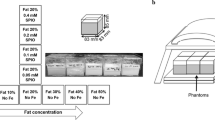Abstract
The demand for measurement of visceral fat in medical checkups is increasing because of attention to central obesity. Computed tomography is widely used for this purpose, but carries risks associated with radiation exposure. Fast imaging with a dual-echo technique acquiring water and fat signals both in-phase and out-of-phase using magnetic resonance imaging is desirable, but not all scanners are capable of this technique. We tried to quantify fat content by using a dual-echo gradient echo pulse sequence with an arbitrary echo time (TE) set. We calculated the phase change during the TE interval and extracted the region of fat by threshold processing. Variations in the precision of counting fat pixels caused by differences between TE1 and TE2 were measured in phantom experiments. We then evaluated the validity of this method by examination of a volunteer. The phantom study showed a large error when the TE interval was a multiple of the in-phase time for fat and water, and the error increased according to the prolongation of the TE. In the human study, phase wrap** readily occurred in the phase-change image. However, the region of fat was easily extracted with high-pass filtering. The fat signal can also be extracted by use of scanners that cannot be set simultaneously to in-phase and out-of-phase TE.






Similar content being viewed by others
References
Committee to evaluate diagnostic standards for metabolic syndrome. Definition and the diagnostic standard for metabolic syndrome. Nippon Naika Gakkai Zasshi. 2005;94:794–809.
Examination Committee of Criteria for ‘Obesity Disease’ in Japan; Japan Society for the Study of Obesity. New criteria for ‘obesity disease’ in Japan. Circ J 2002;66:987–92.
Yoshizumi T. Relationship between the criteria for metabolic syndrome and the evaluation of abdominal fat distribution measured by CT scan. Jpn J Radiol Technol. 2007;63:276–84.
Yamamoto S, Nakagawa T, Kusano S, Takamura M, Hattori K, Irokawa M. Development of automated diagnosis system CT screening for visceral obesity. MEDIX. 2004;41:15–20.
Yoshizumi T, Nakamura T, Yamane M, Islam AH, Menju M, Yamasaki K, et al. Abdominal fat: standardized technique for measurement at CT. Radiology. 1999;211:283–6.
Jensen MD, Kanaley JA, Reed JE, Sheedy PF. Measurement of abdominal and visceral fat with computed tomography and dual-energy x-ray absorptiometry. Am J Clin Nutr. 1995;61:274–8.
Gerard EL, Snow RC, Kennedy DN, Frisch RE, Guimaraes AR, Barbieri RL, et al. Overall body fat and regional fat distribution in young women: quantification with MR imaging. AJR Am J Roentgenol. 1991;157:99–104.
Thomas EL, Saeed N, Hajnal JV, Brynes A, Goldstone AP, Frost G, et al. Magnetic resonance imaging of total body fat. J Appl Physiol. 1998;85:1778–85.
Rybicki FJ, Mulkern RV, Robertson RL, Robson CD, Chung T, Ma J. Fast three-point Dixon MR imaging of the retrobulbar space with low-resolution images for phase correction: comparison with fast spin-echo inversion recovery imaging. AJNR Am J Neuroradiol. 2001;22:1798–802.
Siegel MJ, Hildebolt CF, Bae KT, Hong C, White NH. Total and Intraabdominal fat distribution in preadolescents and adolescents: measurement with MR imaging. Radiology. 2007;242:846–56.
Qayyum A, Goh JS, Kakar S, Yeh BM, Merriman RB, Coakley FV. Accuracy of liver fat quantification at MR imaging: comparison of out-of-phase gradient-echo and fat-saturated fast spin-echo techniques—initial experience. Radiology. 2005;237:507–11.
Tanaka S, Yoshiyama M, Imanishi Y, Nakahira K, Hanaki T, Naito Y, et al. MR measurement of visceral fat: assessment of metabolic syndrome. Magn Reson Med Sci. 2006;5:207–10.
Gomi T, Kawawa Y, Nagamoto M, Terada H, Kohda E. Measurement of visceral fat/subcutaneous fat ratio by 0.3 tesla MRI. Radiat Med. 2005;23:584–7.
Ma J. Breath-hold water and fat imaging using a dual-echo two-point Dixon technique with an efficient and robust phase-correction algorithm. Magn Reson Med. 2004;52:415–9.
Namimoto T, Yamashita Y, Mitsuzaki K, Nakayama Y, Makita O, Kadota M, et al. Adrenal masses: quantification of fat content with double-echo chemical shift in-phase and opposed-phase FLASH MR images for differentiation of adrenal adenomas. Radiology. 2001;218:642–6.
Hussain HK, Chenevert TL, Londy FJ, Gulani V, Swanson SD, McKenna BJ, et al. Hepatic fat fraction: MR imaging for quantitative measurement and display–early experience. Radiology. 2005;237:1048–55.
Arai N, Miyati T, Matsunaga S, Motono Y, Ueda Y, Kasai H, et al. New method of determining regional fat fraction with modulus and real multiple gradient-echo (MRM-GRE). Jpn J Radiol Technol. 2007;63:312–8.
Hirooka M, Kumagi T, Kurose K, Nakanishi S, Michitaka K, Matsuura B, et al. A technique for the measurement of visceral fat by ultrasonography: comparison of measurements by ultrasonography and computed tomography. Intern Med. 2005;44:794–9.
Chiba Y, Saitoh S, Takagi S, Ohnishi H, Katoh N, Ohata J, et al. Relationship between visceral fat and cardiovascular disease risk factors: the Tanno and Sobetsu study. Hypertens Res. 2007;30:229–36.
Ribeiro-Filho FF, Faria AN, Azjen S, Zanella MT, Ferreira SR. Methods of estimation of visceral fat: advantages of ultrasonography. Obes Res. 2003;11:1488–94.
Wang Y, Yu Y, Li D, Bae KT, Brown JJ, Lin W, et al. Artery and vein separation using susceptibility-dependent phase in contrast-enhanced MRA. J Magn Reson Imaging. 2000;12:661–70.
Reichenbach JR, Barth M, Haacke EM, Klarhofer M, Kaiser WA, Moser E. High-resolution MR venography at 3.0 Tesla. J Comput Assist Tomogr. 2000;24:949–57.
Haacke EM, Xu Y, Cheng YC, Reichenbach JR. Susceptibility weighted imaging (SWI). Magn Reson Med. 2004;52:612–8.
Acknowledgments
The authors thank Hiroyuki Kabasawa, Ph. D. (Graduate School of Medicine, University of Tokyo) for useful advice with data processing. This work was supported in part by a grant-in-aid for area contribution from Ibaraki Prefectural University of Health Sciences.
Author information
Authors and Affiliations
Corresponding author
About this article
Cite this article
Ishimori, Y., Monma, M., Sakurai, H. et al. Fat quantification by use of phase change in dual-echo magnetic resonance imaging. Radiol Phys Technol 1, 89–94 (2008). https://doi.org/10.1007/s12194-007-0010-1
Received:
Revised:
Accepted:
Published:
Issue Date:
DOI: https://doi.org/10.1007/s12194-007-0010-1




